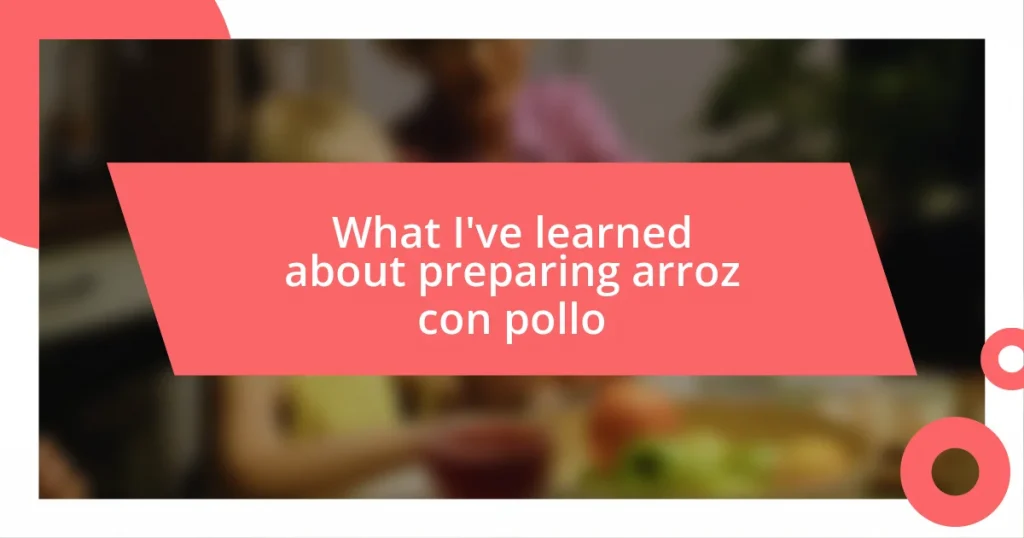Key takeaways:
- The exploration of Amazonian ingredients reveals rich cultural stories and their significant roles in sustainability and biodiversity.
- Researching sustainable sourcing methods involves agroforestry, community initiatives, and ethical certifications, showcasing local farmers’ dedication to environmental preservation.
- Incorporating Amazonian ingredients into recipes fosters creativity, evokes nostalgic memories, and enhances connection through shared culinary experiences.

Understanding Amazonian Ingredients
When I first began exploring Amazonian ingredients, I was amazed by the vast array of unique plants and their surprising uses. Each ingredient tells a story, often rooted in centuries of indigenous knowledge and cultural practices. Isn’t it fascinating how some of these plants have the power to heal or nourish us in ways that modern science is just beginning to understand?
One particular memory that sticks with me is my first encounter with açaí berries while visiting a local market in Brazil. The vibrant purple hue and distinct aroma captivated me; tasting them fresh was an experience like no other. This moment made me realize how deeply interconnected our food sources are with the environment. Have you ever wondered how something so simple could carry the essence of an entire ecosystem?
Understanding these ingredients goes beyond mere curiosity; it’s about recognizing their role in sustainability and biodiversity. For instance, the use of ingredients like guaraná not only highlights the innovation behind local cuisine but also underscores the importance of preserving these natural resources for future generations. Reflecting on this, I often ask myself: how do we balance appreciation for these treasures while ensuring they are protected?

Researching Sustainable Sourcing Methods
Researching sustainable sourcing methods has been an enlightening journey for me. Recently, I connected with local farmers in the Amazon who are fiercely committed to preserving their environment while providing unique ingredients. It was heartwarming to see their passion for sustainable practices, as they shared stories of how traditional techniques can coexist with modern demands.
Here are a few key methods I discovered during my research:
– Agroforestry: This technique combines agriculture with forestry, promoting biodiversity and maintaining healthy ecosystems.
– Community-led initiatives: Collaborating with local communities ensures that sourcing supports their livelihoods and preserves traditional knowledge.
– Certification programs: Seeking out fair trade or organic certifications helps guarantee that sourcing practices are ethical and responsible.
– Seed saving: Encouraging the use of heirloom varieties helps maintain genetic diversity and protects local ecosystems.
Each method reflects a dedication to the land and its people, and I felt a strong emotional connection to their resilience and ingenuity. I often think about how these practices can lead to a more sustainable future, and it’s inspiring to witness firsthand the commitment to protecting these invaluable resources.

Identifying Unique Flavor Profiles
Identifying unique flavor profiles in Amazonian ingredients is like embarking on a sensory adventure. I remember tasting a splash of salted Brazil nuts for the first time; their creamy, buttery texture, paired with a hint of earthiness, completely shifted my perception of nuts. I’ve come to realize that every bite carries the essence of the Amazon, evoking the landscape’s vibrancy and richness. Have you ever noticed how certain flavors can transport you to a different place?
Exploring the nuances between similar ingredients, such as the tangy brilliance of camu camu versus the sweet-sour kick of açaí, has opened my eyes to the complexity of their profiles. For example, camu camu is often touted for its incredible vitamin C content, yet its bright tartness can enhance both sweet and savory dishes. I find myself asking: how often do we overlook these ingredients while cooking? By experimenting with these flavors, I often uncover surprising pairings that elevate a dish to a new level.
In my culinary journey, I’ve learned that scent plays a crucial role in flavor perception. One particularly memorable experience was inhaling the intoxicating aroma of fresh cupuaçu. It was reminiscent of a tropical fusion between chocolate and pineapple, making it a versatile addition to both desserts and savory dishes. Each ingredient not only brings its own flavor but also offers a chance to connect with the culture and tradition behind it. How beautiful is it to know that every dish can be a canvas for the stories these ingredients carry?
| Ingredient | Flavor Profile |
|---|---|
| Açaí | Sweet, berry-like, earthy |
| Camu Camu | Tart, tangy, bright |
| Brazil Nut | Creamy, buttery, earthy |
| Cupuaçu | Chocolatey, fruity, tropical |

Experimenting with Cooking Techniques
Experimenting with cooking techniques opens up a world of possibilities when working with Amazonian ingredients. One time, I decided to try slow-roasting some freshly harvested hearts of palm, drizzled with a bit of local honey and sprinkled with sea salt. The transformation from crisp and raw to tender and sweet was magical; it completely changed my perception of this ingredient. Have you ever tried cooking something in a way that surprised you? Those moments are where the real culinary magic happens.
I’ve often found joy in combining diverse methods, such as steaming and grilling. For instance, I once grilled bananas to enhance their natural sweetness while preserving their caramel-like aroma. The smoky flavor paired with the banana’s creaminess was an epiphany for my taste buds. I like to think of cooking as a blend of art and science. Isn’t it fascinating how the same ingredient can yield completely different results based on how we manipulate heat and time?
Incorporating non-traditional techniques has also been rewarding. One of my favorite experiments involved fermenting Amazonian roots to create a unique tangy side dish. Watching the transformation from starchy to pleasantly sour is an adventure itself. I still remember the first taste—it was unexpected and delightful, encouraging me to think beyond conventional approaches. Isn’t it thrilling to discover new dimensions to familiar ingredients? Through these culinary explorations, I’ve realized the importance of being daring and curious in the kitchen.

Using Tools for Ingredient Preparation
When it comes to preparing Amazonian ingredients, I can’t overstate the importance of the right tools. A high-quality mortar and pestle, for example, can elevate the way I process fresh herbs and spices. I recall grinding down fragrant fresh ginger with a bit of salt just before adding it to a sauce—it’s incredible how much depth that one step adds. Have you ever noticed how the texture changes the flavor experience?
I often turn to simple tools like sharp knives and cutting boards to respect the ingredients I work with. The crisp sound of chopping ripe papaya or creamy avocado feels almost meditative. I remember slicing up some juicy soursop, and how the evening light caught the creamy flesh—it made the act of preparing food feel sacred. The right knife can make all the difference; it’s surprising how a simple tool can enhance my connection to the ingredient.
Another favorite tool of mine is a bamboo steamer, especially for delicate ingredients like fish or greens. Using it to steam slices of fish seasoned with herbs gives the dish a gentle, moist finish that unlocks the natural flavors beautifully. There’s something deeply satisfying about watching the steam dance and knowing that I’m preserving the ingredient’s essence while cooking. What tools do you gravitate towards for your culinary creations? I believe our choices reflect our journey in the kitchen, crafting experiences that are both personal and delightful.

Incorporating Ingredients into Recipes
Incorporating Amazonian ingredients into my recipes is often an adventure that starts with imagination. For example, when I first encountered cacao nibs, I hesitated but then decided to sprinkle them over a creamy avocado mousse. The bitterness of the nibs contrasted beautifully with the rich creaminess, creating an unexpected yet delightful flavor journey that surprised me with each bite. Have you ever found joy in such a seemingly risky combination?
When I embark on creating a dish, I find it’s the texture that often captivates my senses. Last week, I tossed freshly picked Amazonian river shrimp into a vibrant stir-fry, letting their natural sweetness shine. As I combined them with crunchy peppers and fragrant herbs, the colors popped, and the aroma in my kitchen was intoxicating. It made me realize that recipes are not just about ingredients; they’re about the experiences and feelings they evoke as they come together. What culinary memories and emotions do your favorite dishes hold?
One essential aspect of incorporating these ingredients is understanding their unique characters. For instance, using the earthy notes of Amazonian black rice, I crafted a risotto that felt both comforting and exotic. As I stirred in coconut milk and a squeeze of lime, the colors transformed, and the dish became a celebration of textures and flavors on the plate. I sometimes ask myself—how can an ingredient tell a story? The answer often lies in how I embrace and weave it into my culinary tapestry.

Sharing Experiences and Outcomes
Sharing experiences with Amazonian ingredients is like unearthing treasures that tell stories. I distinctly remember the first time I encountered aji amarillo, a vibrant yellow chili. I ventured into creating a spicy sauce for grilled fish, and the resulting burst of flavor was exhilarating. It made me ponder: how often do we shy away from bold flavors, only to discover they can elevate a dish beyond our imagination?
One memorable evening, I hosted a small dinner party where I introduced guests to the wonders of Amazonian herbs. As I infused fresh cilantro and lemongrass into a broth, I could see curiosity reflected in their faces. Their enthusiastic reactions to the fragrant aroma reminded me how food can connect us. It’s a reminder that not only do these ingredients enhance our meals, but they also spark joy and connection among those who share the experience.
The outcomes of integrating these ingredients are not just delicious—they’re deeply personal. For instance, crafting a dessert with Brazil nuts, I was transported back to my childhood, enjoying crunchy snacks on family outings. The nostalgic flavors resonated with my guests, leading to shared stories and laughter around the table. Isn’t it amazing how food has the power to evoke memories and create new ones? Each experience adds another thread to the fabric of our culinary journey.















